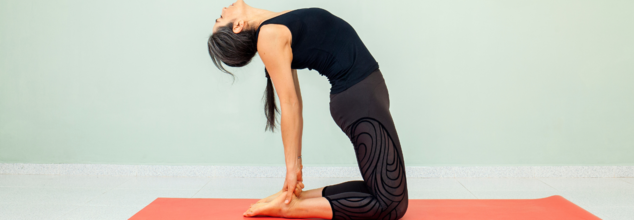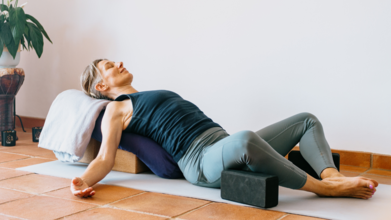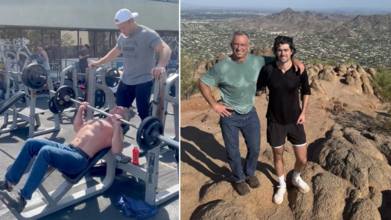- Health Conditions A-Z
- Health & Wellness
- Nutrition
- Fitness
- Health News
- Ayurveda
- Videos
- Medicine A-Z
- Parenting
- Web Stories
Strong Ankles, Less Injuries: Yoga Poses That Can Help Strengthen Your Ankle

(Credit-Canva)
Do you often worry about twisting your ankle? Are you experiencing foot pain, balance issues, or decreased mobility as you get older? These could all be signs that your ankles are weak. While you may not notice it as much, ankles are a big part of our balance and strength foundation. They support our movements, whether it is walking, running, stretching, or even simple flexing.
When our ankles grow weak, things and situations start changing, however you may not realize it may be due to your weak ankles. You may be getting into situations like twisting your ankles more often, experiencing pain during normal movements, etc. The Cleveland Clinic explains that weak ankles have a great effect on your knees and hips. They explained that deficient ankles cause more strain on your knees as well as the internal rotation of your hips, ultimately making it difficult to walk. However, it can be improved.
Yoga Poses for Strong Ankles
The good news is that you can actively work to strengthen these crucial ankle muscles and the connective tissues around them. This effort will not only help prevent injuries but also significantly improve your balance and overall movement. Here are some yoga poses you can do to improve your ankle health.
Camel Pose (Ustrasana)
This pose involves kneeling and arching your back, reaching for your heels. It strengthens the front of the ankles and feet while also improving overall stability and flexibility in the lower body. As you press your shins and tops of your feet into the ground, your ankles engage to support the pose.
Chair Pose (Utkatasana)
Imagine sitting in an invisible chair. This pose deeply engages the muscles in your calves and ankles as you lower your hips. It builds strength in the entire foot and ankle complex, improving stability and endurance, which are crucial for preventing ankle rolling during daily activities or sports.
Child's Pose (Balasana)
While primarily a resting pose, Child's Pose can gently stretch the top of your feet and ankles, especially if you sit back on your heels. It helps to release tension and improve flexibility in the ankle joint, which is important for overall ankle health and reducing stiffness.
Cow Face Pose (Gomukhasana)
This seated pose involves stacking your knees. While the main focus is on the hips, the feet and ankles are gently stretched and aligned. It encourages external rotation in the ankles and can help release tension, improving overall ankle mobility and preventing common stiffness that can lead to injury.
Eagle Pose (Garudasana)
Standing on one leg while wrapping the other around it, Eagle Pose is a powerful balance pose that significantly challenges and strengthens the stabilizing muscles around your standing ankle. It builds incredible ankle stability, proprioception (your body's awareness in space), and improves overall balance, making your ankles more resilient against twists and sprains.
Easy Pose (Sukhasana)
A simple cross-legged seated pose, Easy Pose might seem basic, but it's foundational for ankle flexibility. It gently stretches the ankles and feet, improving comfort in seated positions and maintaining mobility in the joint. This consistent gentle stretching helps prevent stiffness that can contribute to weak ankles.
Eight-Angle Pose (Astavakrasana)
This advanced arm balance requires significant core and arm strength, but it also heavily relies on strong and flexible ankles to hook around the arm and support the body's weight. It dramatically builds strength and control in the entire ankle joint, demanding high levels of stability and engagement.
Extended Hand-to-Big-Toe Pose (Utthita Hasta Padangusthasana)
This standing balance pose involves extending one leg forward or to the side. It greatly challenges the stabilizing muscles of your standing ankle. Holding this pose strengthens the ankle's ability to maintain balance and withstand shifts in weight, crucial for preventing common ankle injuries during movement.
HIIT Workouts Suit You Ill? LIIT May Be Your Exercise Style

Many of us believe that a good workout has to leave us completely exhausted and drenched in sweat. But is that the only way? Like many other things in life, exercise is also different for everyone. The best way to go about exercising is finding out your priorities and goals. If you want faster results and do not mind intense workouts, tailor your time and workouts according to that. But what about people who do like exhausting workouts and like to take things slow? Exercise doesn't need to be a grueling test of endurance. There's a gentler way to get fit, and it's called Low-Intensity Interval Training, or LIIT. This approach lowers your effort level while still helping you reach your fitness goals.
What is LIIT?
The Cleveland Clinic explains that the main idea behind LIIT is to exercise for longer stretches of time at a low to moderate effort level, with short breaks built in for you to recover. You'll definitely feel like you're doing something, and your body will be working, but you won't push yourself too hard or feel completely wiped out. During a LIIT workout, you should be able to:
- Talk comfortably and hold a conversation without getting out of breath. If you're gasping for air, you're probably pushing too hard for LIIT.
- Keep your heart rate in a comfortable zone, specifically what's called Zone 2. This means your heart is beating at roughly 60% to 70% of its maximum rate during exercise. (Imagine a scale from 1 to 5 for how hard your heart is working; Zone 2 is on the lower, easier end.)
- LIIT requires less energy than most other workouts. The goal is to challenge yourself just enough at an effort level you can comfortably keep up for a longer time. It’s about being consistent and sustainable, rather than super intense.
Gentler Approach to Fitness
LIIT is the calmer relative of High-Intensity Interval Training (HIIT). HIIT has become very popular over the years because it involves short bursts of very challenging exercise that push you to your absolute limits.
You can actually do the same kinds of exercises in both LIIT and HIIT programs, like running, cycling, or lifting weights. The big difference is how hard you push yourself during those exercises. HIIT is all about maximum effort, where you give it everything you've got.
In a HIIT workout, you'll definitely feel out of breath, and your heart rate will be very high, close to your maximum. Because it's so physically demanding, HIIT sessions are typically much shorter than LIIT sessions.
Both HIIT and LIIT can improve your fitness, but they do it in different ways. HIIT is generally better for building muscle and strength. LIIT, on the other hand, might burn more calories overall because the workouts last longer.
Ultimately, the best choice for you depends on what you're trying to achieve and what fits your lifestyle. Experts suggest that HIIT is usually best for athletes who are already very fit and work out regularly. Pushing yourself extremely hard can put a lot of stress on your body and heart, and that's not for everyone. Even if you do intense HIIT workouts, adding occasional LIIT sessions can help your body recover and prevent burnout.
How to Do LIIT Workouts
Almost any physical activity can be turned into a LIIT workout. It's simply a matter of adjusting how hard you push yourself and splitting your exercise time into active periods and short rest breaks. Here are some examples:
Running
Try running at a comfortable pace for one minute, then slow down to a walk for two minutes to recover. You can go back and forth between running and walking for as many rounds as you like, adjusting the times to match how you feel.
Walking
The idea is similar to running. Walk at a faster pace for five minutes, then slow down for two minutes for a recovery period. Repeat this cycle as many times as you want.
Cycling
Pedal at a moderate effort level for five minutes, then slow your pace for two minutes. Keep repeating these intervals.
Rowing
Row for a certain distance, like 100 meters, at a moderate intensity, then slow your pace for two minutes. Repeat these intervals as desired.
Yoga For Beginners - How Modifications Can Help You Ease Into Yoga

Yoga has many poses, sometimes called asanas, with 84 main ones and millions of variations. Whether you're new to yoga or have practiced for years, the most important thing isn't to do every pose perfectly. Instead, it's about moving your body in ways that feel good and don't cause injury. As a beginner you must learn how to make yoga poses easier for you, this can actually make your practice much stronger overall.
What "Modifying" a Yoga Pose Means
Yoga is an ancient practice, and the pictures you often see show the most advanced versions of poses. Some of these can be very hard and take years to achieve. When you modify a yoga pose, you're simply adjusting it to fit your own skill level.
Sometimes, when people hear "modification," they might feel like they can't do a pose. But if you understand why you're doing a pose, you can choose an option that feels comfortable for your body.
How to Know When to Modify a Pose
The Cleveland Clinic explains that the first sign you need to change a yoga pose is pain. If you get into a pose and it feels a little uncomfortable or tight because you're stretching, that's okay. However, if something hurts, you need to stop. Don't try to push through pain. If it hurts, you should adjust the pose right away.
Yoga Stretching Tips for Beginners
Let's go back to those uncomfortable feelings. When you're stretching, remember that it takes time for your muscles to relax and lengthen. Your breathing is a huge part of this process.
If you push too far too quickly, your muscles will tighten up, which is the opposite of what you want. It takes about eight seconds for your muscles to even understand what you're trying to do. When stretching, start very gently and slowly go deeper. Also, focus on your breath. When you breathe out, that's the part where your body releases and relaxes. So, focus on exhaling as you try to stretch a little bit further. Here are some poses and how can you modify them.
Downward-Facing Dog
This pose stretches your whole body, forming an upside-down "V." Push into your hands and feet, lifting hips high. For comfort, bend your knees if hamstrings are tight, or place blocks under your hands for wrist support. You can also widen your feet for more stability and a gentler stretch.
Warrior II
Warrior II is a strong standing pose building leg and core strength while opening hips. Stand with one foot forward, knee bent over ankle, other foot turned out, arms stretched sideways. To modify, shorten your stance, avoid bending your front knee too deeply, or place hands on hips to ease shoulder strain, maintaining balance.
Seated Forward Fold
This relaxing pose stretches your hamstrings, spine, and shoulders. Sit with legs extended, then gently fold from hips, reaching towards feet or shins. If hamstrings are tight, bend your knees a lot. Use a strap around your feet or sit on a folded blanket to help you hinge comfortably.
Tree Pose
Tree pose requires balance. Stand on one leg, placing the other foot on your inner thigh or shin (avoiding the knee). For support, use a chair nearby to hold onto until you feel steady. You can also start by keeping your toes on the floor, with your heel just above your ankle, before lifting your foot higher.
Pigeon Pose
Pigeon pose can be intense for tight hips. One leg bends in front, the other stretches behind. To modify, place a blanket under your hips for support. You can also adjust your leg position into a "zigzag" shape by bringing the back knee forward, which still provides a good hip stretch comfortably.
Using Blocks for Balancing Poses (like Triangle or Half Moon)
For poses that involve bending sideways toward the floor, such as Triangle Pose and Half Moon, yoga blocks are very useful. Place a block under your hand instead of trying to reach the floor. This provides essential support, helps maintain proper body alignment, and ensures you get the correct stretch without straining.
RFK Wears Jeans On A Hike And To Gym, Why Is It A Bad Idea?

Credits: X
Robert F. Kennedy Jr., the U.S. Health Secretary and a well-known fitness enthusiast, has become the center of a new controversy. This time, it is not over policy, but his workout attire.
Kennedy was recently spotted hiking up Arizona’s Camelback Mountain in a pair of dark blue jeans on a scorching 107°F day, as reported by The Guardian. Photos of him drenched in sweat while climbing in a T-shirt and jeans quickly went viral, prompting both admiration for his stamina and concern for his sartorial and safety choices.
Kennedy, known for his unconventional stances on various health issues, has developed a pattern of working out in jeans.
Whether it’s hiking, lifting weights, or even wading into creeks, he seems committed to denim regardless of the activity or weather conditions.
While some fans praised his grit, others questioned the health implications of exercising in such restrictive clothing, especially given that the Centers for Disease Control and Prevention (CDC), which falls under his department, advises people to wear "loose, lightweight, light-colored clothing" during extreme heat to avoid heatstroke and other complications.
Why Denim Isn’t Built for the Gym
While Kennedy’s denim devotion has captured public attention, fitness experts and health professionals advise caution when it comes to choosing workout attire.
Here’s why jeans aren’t the best choice for physical activity:
Restricted Range of Motion
Jeans are typically made from thick, non-stretchy fabric, which can severely limit mobility during exercise. Movements required in activities like squats, lunges, and even basic stretching become difficult, which not only reduces workout effectiveness but may also increase the risk of injury.
Personal trainer Justin Kraft, speaking to Newsweek, pointed out that restricting motion can be harmful, especially for those with pre-existing conditions like high blood pressure or sciatica.
Low Breathability and Overheating
Unlike moisture-wicking fabrics found in gym wear, denim traps heat and sweat. In hot weather or high-intensity workouts, this lack of breathability can lead to overheating, discomfort, and even heat exhaustion. The Guardian noted that Kennedy hiked during record-breaking Arizona heat, despite warnings from the CDC about dressing appropriately in extreme temperatures.
Chafing and Skin Irritation
Chafing is a common side effect of exercising in jeans. The seams and heavy fabric can rub harshly against the skin, particularly in areas like the inner thighs, leading to painful rashes or abrasions.
Not Designed for Functionality
While jeans might offer some resistance, experts say there are better alternatives for those looking to add intensity to workouts. Weighted vests, resistance bands, slam balls, and other functional gear provide added challenge without compromising comfort or safety..
© 2024 Bennett, Coleman & Company Limited

